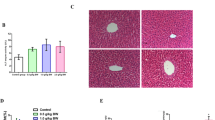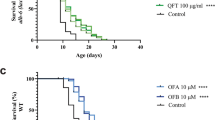Abstract
The infusion tea extracted from the leaves of the plant Camellia sinensis can be used in the prevention of cancer, cardiovascular and neurodegenerative diseases, and aging, while adriamycin (ADR) is an anticancer drug that increases oxidative stress in cells. The present study evaluated the protective effect of the long-term consumption of white tea used at two different doses against the oxidative stress produced by aging and acute oxidation caused ADR treatment. At wearing, rats received distilled water (control), or 0.15 (dose 1) or 0.45 mg (dose 2) of solid tea extract/kilogram body weight in their drink. At 12 months, about half of the rats of each group were injected with a bolus of ADR, and six rats of the control group with an injection of saline solution and sacrificed. The rest of the animals continued in their cages until 24 months of age, when they were sacrificed. Lipid and protein oxidation of liver and brain microsomes was analyzed by measuring hydroperoxide and carbonyl levels. White tea consumption for 12 months at a non-pharmacological dose was seen to reverse the oxidative damage caused by ADR in both liver and brain, while the consumption of white tea for 20 months at a non-pharmacological dose had no effect on carbonyl or hydroperoxides in these tissues. The long-term ingestion of white tea protected tissues from acute oxidative stress but did not affect chronic oxidative agents such aging.


Similar content being viewed by others
References
Almajano MP, Carbó R, Jiménez JAL, Gordon MH (2008) Antioxidant and antimicrobial activities of tea infusions. Food Chem 108:55–63. https://doi.org/10.1016/j.foodchem.2007.10.040
Almajano MP, Vila I, Gines S (2011) Neuroprotective effects of white tea against oxidative stress-induced toxicity in striatal cells. Neurotox Res 20:372–378. https://doi.org/10.1007/s12640-011-9252-0
Alves MG, Martins AD, Teixeira NF et al (2015) White tea consumption improves cardiac glycolytic and oxidative profile of prediabetic rats. J Funct Foods 14:102–110. https://doi.org/10.1016/j.jff.2015.01.019
Azman NAM, Peiró S, Fajarí L et al (2014) Radical Scavenging of White Tea and Its Flavonoid Constituents by Electron Paramagnetic Resonance (EPR) Spectroscopy. J Agric Food Chem 62:5743–5748. https://doi.org/10.1021/jf501707p
Bailey PJ (2001) The cleavage of a cluster carbonylnext term C–O bond by trifluoromethanesulphonic anhydride. J Organomet Chem 420:21–23
Carloni P, Tiano L, Padella L et al (2012) Antioxidant activity of white, green and black tea obtained from the same tea cultivar. Food Res Int. https://doi.org/10.1016/j.foodres.2012.07.057
Catalá A, Zvara A, Puskás LG, Kitajka K (2007) Melatonin-induced gene expression changes and its preventive effects on adriamycin-induced lipid peroxidation in rat liver. J Pineal Res 42:43–49. https://doi.org/10.1111/j.1600-079X.2006.00354.x
Coimbra S, Santos-Silva A, Rocha-Pereira P et al (2006) Green tea consumption improves plasma lipid profiles in adults. Nutr Res 26:604–607. https://doi.org/10.1016/j.nutres.2006.09.014
Dean RT, Fu S, Stocker R, Davies MJ (1997) Biochemistry and pathology of radical mediated protein oxidation. Biochem J 324:1–18
Dias TR, Alves MG, Rato L et al (2016) White tea intake prevents prediabetes-induced metabolic dysfunctions in testis and epididymis preserving sperm quality. J Nutr Biochem 37:83–93. https://doi.org/10.1016/j.jnutbio.2016.07.018
Duthie GG, Duthie SJ, Kyle AM (2000) Plant polyphenols in cancer and heart disease: implications as nutritional antioxidants. Nutr Res Rev 13:340–357
Erba D, Grass L, Josephy D et al (2002) A comparison of the anticarcinogenic properties of four red wine polyphenols. Clin Biochem 35:119–124
Espinosa C, López-Jiménez JÁ, Cabrera L et al (2012) Protective effect of white tea extract against acute oxidative injury caused by adriamycin in different tissues. Food Chem 134:1780–1785
Espinosa C, López-Jiménez JA, Pérez-Llamas F et al (2015) Long-term intake of white tea prevents oxidative damage caused by adriamycin in kidney of rats. J Sci Food Agric. https://doi.org/10.1002/jsfa.7483
Espinosa C, Pérez-Llamas F, Guardiola FA et al (2014) Molecular mechanisms by which white tea prevents oxidative stress. J Physiol Biochem. https://doi.org/10.1007/s13105-014-0357-9
Esterbauer H (1996) Estimation of peroxidative damage: a critical review. Pathol Biol Paris 44:25–28
Goodman J, Hochstein P, Angeles L (1977) Generation of free radicals and lipid peroxidation by redox cycling of adriamycin and daunomycin. Biochem Biophys Res Commun 77:797–803
Halliwell B, Gutteridge JMC (1989) Comments on review of free radicals in biology and medicine. Free Radic Biol Med 12:93–95
Jacob R (1995) The integrated antioxidant system. Nutr Res 15:755–766
Jiang Z-Y, Hunt JV, Wolff SP (1992) Ferrous Iron oxidation in the presence of xylenol orange for detection of lipid hydroperoxide in low density lipoprotein. Anal Biochem 202:384–389
Juśkiewicz J, Zduńczyk Z, Jurgoński A et al (2008) Extract of green tea leaves partially attenuates streptozotocin-induced changes in antioxidant status and gastrointestinal functioning in rats. Nutr Res 28:343–349. https://doi.org/10.1016/j.nutres.2008.03.004
Khan SA, Priyamvada S, Arivarasu NA et al (2007) Influence of green tea on enzymes of carbohydrate metabolism, antioxidant defense, and plasma membrane in rat tissues. Nutrition 23:687–695. https://doi.org/10.1016/j.nut.2007.06.007
Kim M-J, Choi J-H, Yang J-A et al (2002) Effects of green tea catechin on enzyme activities and gene expression of antioxidative system in rat liver exposed to microwaves. Nutr Res 22:733–744
Koutelidakis AE, Argiri K, Serafini M et al (2009) Green tea, white tea, and Pelargonium purpureum increase the antioxidant capacity of plasma and some organs in mice. Nutrition 4:453–458
Koutelidakis AE, Serafini M, Komaitis M, Kapsokefalou M (2010) Oxidative activity of some iron compounds on colon tissue homogenates from mice after administration of green tea, white tea and Pelargonium purpureum. Food Chem 120:895–901
Larsson SC, Virtamo J, Wolk A (2013) Black tea consumption and risk of stroke in women and men. Ann Epidemiol 23:157–160. https://doi.org/10.1016/j.annepidem.2012.12.006
Lowry OH, Rosebrough NJ, Farr AL, Randall RJ (1951) Protein measurement with the Folin phenol reagent. J Biol Chem 193:265–275
Mohamadin M, El-Beshbishy H, El-Mahdy M (2005) Green tea extract attenuates cyclosporine A-induced oxidative stress in rats. Pharmacol Res 51:51–57. https://doi.org/10.1016/j.phrs.2004.04.007
Nunes AR, Alves MG, Tomás GD et al (2015) Daily consumption of white tea (Camellia sinensis (L.)) improves the cerebral cortex metabolic and oxidative profile in prediabetic Wistar rats. Br J Nutr 113:832–842. https://doi.org/10.1017/S0007114514004395
Oliveira PF, Tomás GD, Dias TR et al (2015) White tea consumption restores sperm quality in prediabetic rats preventing testicular oxidative damage. Reprod BioMed Online 31:544–556. https://doi.org/10.1016/j.rbmo.2015.06.021
Pérez-Llamas F, González D, Cabrera L et al (2011) White tea consumption slightly reduces iron absorption but not growth, food efficiency, protein utilization, or calcium, phosphorus, magnesium, and zinc absorption in rats. J Physiol Biochem 67:331–337. https://doi.org/10.1007/s13105-011-0079-1
Philipp BW, Shapiro DJ (1979) Improved methods for the assay and activation of 3-hydroxy-3-methylglutaryl coenzyme A reductase. J Lipid Res 20:588–593
Reznick AZ, Packer L (1994) Oxidative damage to proteins: Spectrophotometric method for carbonyl assay. Methods Enzymol 233:257–263
Riccieri V, Spadaro A, Firuzi O et al (2006) Parameters of Oxidative Stress Status in Healthy Subjects : Their Correlations and Stability After Sample Collection. J Clin Lab Anal 148:139–148. https://doi.org/10.1002/jcla
Rice-evans C, Burdon R (1993) Free radical-lipid interaction and their pathological consequences. Prog Lipid Res 32:72–110
Rusak G, Komes D, Likic S et al (2008) Phenolic content and antioxidative capacity of green and white tea extracts depending on extraction conditions and the solvent used. Food Chem 110:852–858
Schimmel KJM, Richel DJ, van den Brink RBA, Guchelaar HJ (2004) Cardiotoxicity of cytotoxic drugs. Cancer Treat Rev 30:181–191
Serafini M, Bellocco R, Wolk A, Ekstrom AM (2002) Total antioxidant potential of fruit and vegetables and risk of gastric cancer. Gastroenterology 123:985–991
Singleton VL, Rossi JA (1965) Colorimetry of total phenolics with phosphor molybdic- phosphotungstic and reagent. Am J Enol Vitic 16:144–158
Stadtman ER, Berlett BS (1997) Reactive oxygen mediated protein oxidation in aging and disease. Chem Res Toxicol 10:485
Suzuki E, Yorifuji T, Takao S et al (2009) Green tea consumption and mortality among japanese elderly people: The prospective Shizuoka elderly cohort. Ann Epidemiol 19:732–739
Tenore GC, Campiglia P, Giannetti D, Novellino E (2015) Simulated gastrointestinal digestion, intestinal permeation and plasma protein interaction of white, green, and black tea polyphenols. Food Chem 169:320–326. https://doi.org/10.1016/j.foodchem.2014.08.006
Tomaszewska E, Winiarska-Mieczan A, Dobrowolski P (2015) Hematological and serum biochemical parameters of blood in adolescent rats and histomorphological changes in the jejunal epithelium and liver after chronic exposure to cadmium and lead in the case of supplementation with green tea vs black, red or white tea. Exp Toxicol Pathol 67:331–339. https://doi.org/10.1016/j.etp.2015.02.005
Verstraeten SV, Keen CL, Schmitz HH et al (2003) Flavan-3-ols and procyanidins protect liposomes against lipid oxidation and disruption of the bilayer structure. Free Radic Biol Med 34:84–92
Wang D, Xu K, Zhong Y et al (2011) Acute and subchronic oral toxicities of Pu-erh black tea extract in Sprague-Dawley rats. J Ethnopharmacol 134:156–164. https://doi.org/10.1016/j.jep.2010.11.068
Winiarska-Mieczan A (2015) The potential protective effect of green, black, red and white tea infusions against adverse effect of cadmium and lead during chronic exposure - A rat model study. Regul Toxicol Pharmacol 73:521–529. https://doi.org/10.1016/j.yrtph.2015.10.007
Zhang Y, Zhang D, Zhu B et al (2016) Effects of dietary green tea polyphenol supplementation on the health of workers exposed to high-voltage power lines. Environ Toxicol Pharmacol 46:183–187. https://doi.org/10.1016/j.etap.2016.07.016
Acknowledgements
This study was funded by “Ministerio de Ciencia y Tecnología” of Spain with the project AGL2005-08088-C02-01 and Beca FPU (AP2006-02642). The authors would like to thank Mª Pilar Almajano for extract of the white tea and Rebeca Martinez-Tomás and Daniel Gonzalez for technical support.
Author information
Authors and Affiliations
Corresponding author
Ethics declarations
All the study protocols were in accordance with the Helsinki Declaration and were approved under supervision of the Bioethical Committee of the Murcia University, Spain.
Conflict of interest
The authors declare that they have no conflicts of interest.
Rights and permissions
About this article
Cite this article
Espinosa Ruiz, C., Cabrera, L., López-Jiménez, J.Á. et al. Effects of long-term ingestion of white tea on oxidation produced by aging and acute oxidative damage in rats. J Physiol Biochem 74, 171–177 (2018). https://doi.org/10.1007/s13105-017-0591-z
Received:
Accepted:
Published:
Issue Date:
DOI: https://doi.org/10.1007/s13105-017-0591-z




